| Reid Lemker |
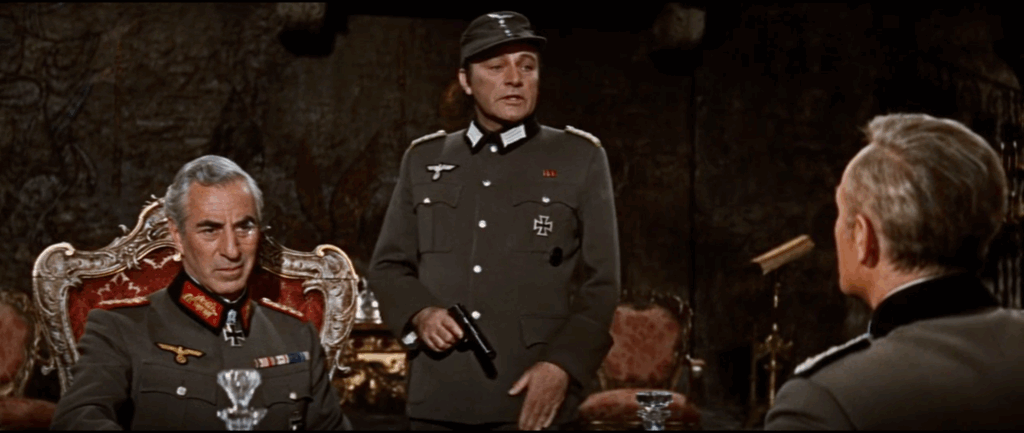
Where Eagles Dare plays at the Trylon Cinema from Sunday, August 3rd, through Tuesday, August 5th. For tickets, showtimes, and other series information, visit trylon.org.
What was the first “adult” movie you saw as a kid? For me, the first movie that comes to mind is Where Eagles Dare. I was probably ten or eleven when my dad first showed it to me, and it quickly became a favorite of ours to watch on a weekend afternoon. I remember being a bit confused by the plot, but I loved the spy elements and all the gadgets. I think I also liked it because it felt so adult. It was mysterious, the plot was complicated, and of course it was violent! Whenever we put it on, I felt like I was being allowed access into a world that was usually off limits. As I have grown up, my attachment to this movie has remained. It’s become comforting and predictable upon repeated viewings. So comforting and predictable that I was actually blown away when I sat down to re-watch it recently after a couple-year hiatus; I’d almost forgotten how great it is.
Released in 1968, Where Eagles Dare stars Richard Burton and Clint Eastwood as British and American spies tasked with breaching a German castle occupied by Nazis. Famously, Burton said he took the role because Elizabeth Taylor’s sons were sick of watching him die at the end of his films and frankly, I can’t blame them. I think it’s fair to say Where Eagles Dare is most famous today for its violent action sequences. However—maybe because of my personal sympathy for Burton or my natural aversion to bullets and blood—I have always been intrigued by the spy elements of this film more than the action elements. It’s the quieter sequences that provide the most intrigue.
One thing the film does quite well is revealing and misdirection. The film slowly, and I’d argue expertly, hints at the ultimate reveal of the larger spy implications without explicitly telling the viewer until the final scene. The radio calls are the first indication that this mission may be more complicated than originally presented. During the first call, the camera starts on Admiral Rolland (Michael Hordern) in a close up as he first asks Smith (Burton) if his fellow British soldier Harrod (Brook Williams) was killed accidentally. The camera remains on Rolland as Smith responds no, and stays on Rolland as he clarifies if Harrod was killed by the Germans. The specificity of the questions and the way that the camera is so interested in Rolland’s response hints to the viewer that there is more to this mission than initially presented. Similarly, I have always loved the later call. At this point in the film Smith has successfully extracted the information from the German generals. Rolland asks Smith, “do you have it?” and the camera stays on Rolland. We only hear Smith respond, “we have it, we have it all.” Rolland cracks a very small smile before responding “all sins forgiven.” It’s the one expression of warm emotion from the Rolland character in the film and it reveals some interesting background on the Smith character.
Beyond the radio dispatches, director Brian G. Hutton also uses the camera to misdirect the viewer. The camera makes a lovely swerve of misdirection when Smith and Schaffer (Clint Eastwood) are sitting together in the German bar. Smith and Schaffer are talking and the camera covers it in shot reverse shot close ups. Just as the flow of the shots has been established Schaffer demands Smith fill him in on the mission. As Smith begins to explain why Schaffer is on the mission, the camera zooms in over Smith’s left shoulder onto the door to the bar. Smith’s audio begins to fade out and the audio picks up the noise from the bar. A second later Mary (Mary Ure) waltzes in and the movie is whisked away on another concurrent storyline. It’s quite an immersive and naturalistic camera movement that fits well in the cramped and tight bar scene. The movement and audio edit effectively dangle an explanation in front of the audience before pulling it back and introducing another storyline.
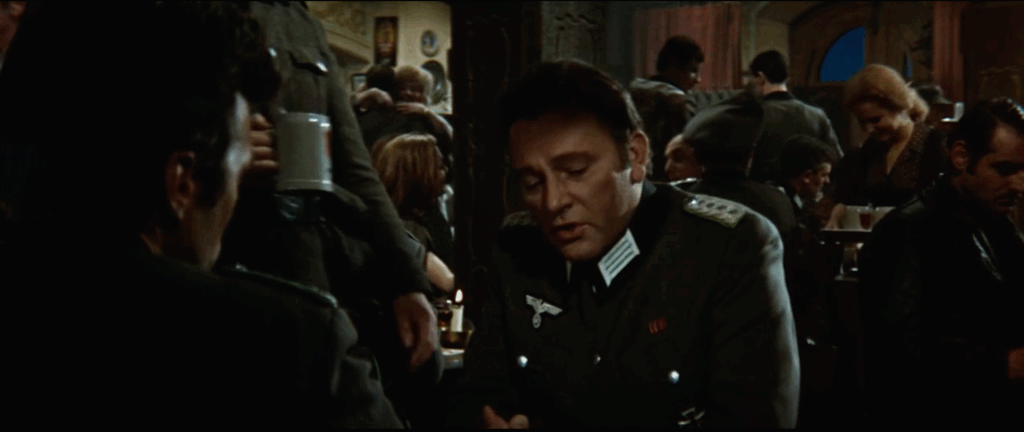
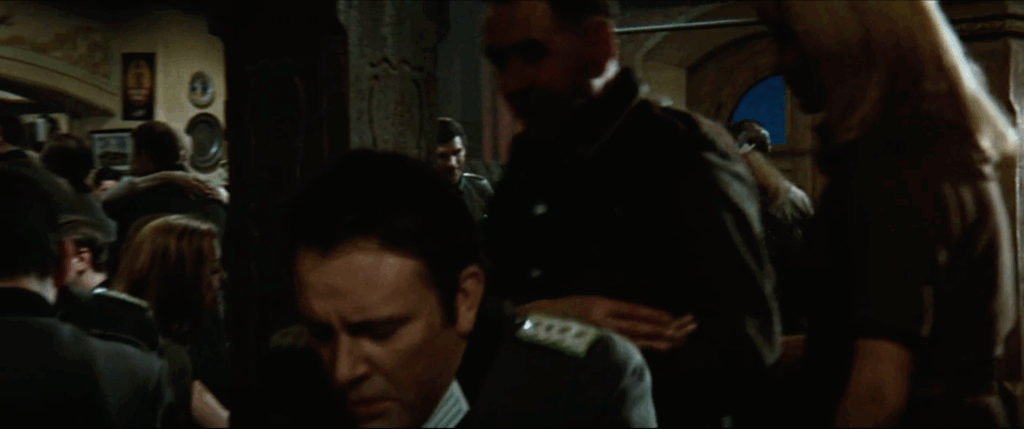
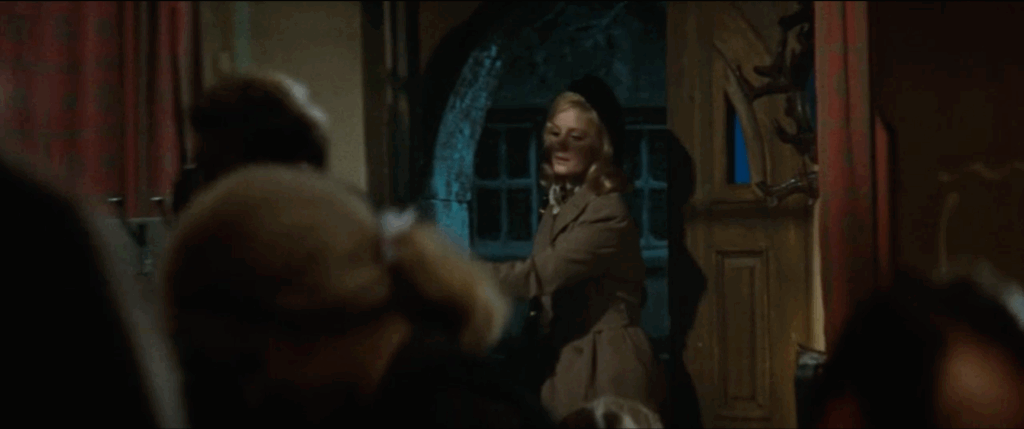
Burton gets his most extended time to shine in the ten-minute sequence within the meeting in the castle. In the scene, Smith takes control of the room and reveals a number of different tales about who he is, who everyone else is, and what they are all doing there. As a viewer, your perception of Smith is subverted almost immediately as he claims to be a German double agent. It’s a lovely way to immediately create suspicion about the character and anything else he is about to say in the scene. As he speaks, Smith circles around the main table and the camera follows him. The camera is stationary on what appears to be the middle of the table slightly looking up at Smith. At times, the camera zooms in close on a face but for most of the scene the camera is stationary and panning with Smith as he moves. The condensed and simple nature of this scene allows Burton to drive the scene as if it’s a stage play. Smith’s dialogue is fantastic. In my opinion, the film is at its best when it’s leaning into Burton’s strengths like this. It’s so exciting to watch him command a room and it’s captivating to watch him reveal information and exploit the fears of everyone present. I’ll toss this scene up against any of the action sequences, I think it’s just as exciting.
Once Burton has outwitted everyone in the meeting room, it’s back to bullets and explosions! The final escape contains all of my favorite action sequences. I love the fight on top of the gondola and using a bus as an escape vehicle always makes me laugh (I have always loved the shot of the bus swiping all the motorcycles as it leaves town). But I think my personal favorite is Schaffer holding off what appears to be about 50 Nazis in a hallway with only two machine guns. What makes this scene for me is the way it cuts back to Smith on the radio shouting over the hail of bullets “Broadsword calling Danny Boy, Broadsword calling Danny Boy” for what feels like five minutes. On my most recent rewatch, I was struck by how much Mary gets involved in the fighting during the escape. She is right there next to Schaffer firing out of the back of the bus as the team escapes. (I recently read a fantastic piece detailing this and other progressive elements of the action sequences in this film).
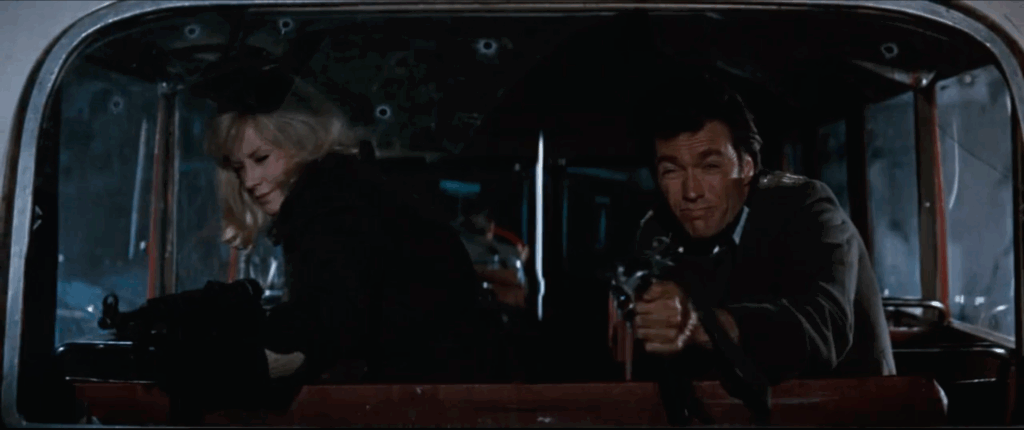
In the end, Smith finally reveals the real rationale for the mission and what was learned. Down to its final minute the film tries to convince the viewer that it may not end as you think it will. But much like how Schaeffer and Smith easily destroy any and all Nazis in their path, Burton towers over anyone he shares a speaking scene with, and Smith’s safety never really feels in doubt. Once again, what stands out is the contrast between the extravagant, almost 40-minute action sequence and this simple showdown in the small space of the plane. The most vivid memory I have of this film comes from this final scene. I was an antsy kid, and when the final enemy was dispatched in the plane, I was ready for the movie to be over. My dad would always make me watch until the end. He loved the last shot of Burton as he finally relaxes and sinks back into the side of the plane before letting out a big sigh and closing his eyes. I never quite understood its importance as a kid, but unsurprisingly, it’s now my favorite shot in the film.
Edited by Olga Tchepikova-Treon
